-

人教版新目标初中英语八年级下册How long have you been collecting shells教案2篇
Step Ⅱ Show the new words on the screen and teach the new words. Read the new words to students and ask them to repeat.Step Ⅲ 3aThis activity introduces new vocabulary and provides reading practice using the target language.In this activity first look at the four pictures.T: What can you see in the pictures?Ss: Four snow globes.T: Right. There are four snow globes in the pictures. And what are they?Ss: They are a monster, two polar bears, two penguins and a birthday cake.Write these words on the blackboard: snow globe; monster; polar bear; penguin and birthday cake. Read them to the class and ask students to repeat each one. Make sure students understand each word.Use a computer to show the E-mail message on the screen and read the message to students.Get students to read the e-mail on their own, and then draw lines connecting each snow globe and its description.Correct the answers.AnswersA line should connect each snow globe picture with the words that describe it in the letter.Step Ⅳ 3bThis activity provides writing practice using the target language.First review Activity 2a on Page 47.Then ask students to complete the message according to Activity 2a.Some partial sentences are given to students. Write about one person's collection.When students work, walk around the room checking the progress and offering help as needed.When they finish, ask some students to read their messages to the class.

人教版新目标初中英语八年级下册Would you mind turning down the music教案
Step 4. Group work (4)1. Ask a pair of students to read the dialogue. Say, This activity provides speaking, listening and writing practice using the target language.2. Ask students to complete the work in groups.3. Check the answers with the whole class. 4. Explain some of the language points. Step 5. Word review (Self check 1)1. Ask students to read the words and the phrases given. 2. Fill in the blanks with proper forms of these words to complete the sentences. 3. Check the answers with the whole class. Homework:Do activity 2 on page 57 after class. Period 6Teaching aims: 1. Teach vocabulary words and the useful expressions. 2. Enable the students to learn etiquette in different culture. 3. Help the students learn how to behave politely in public places and in daily life. Teaching procedures:Step 1. RevisionHelp students to review the function of making requests through a free talk. Then lead them to the topic of etiquette. Explain the meaning of etiquette. Or, ask students to look it up in the dictionary. Step 2. Pre-reading (Section 1)1. Ask students to read the picture and make a list with their partner about how many rules of etiquette can be seen being broken.

人教版新目标初中英语九年级下册By the time I got outside, the bus had already left教案
Ⅰ. Teaching Aims and Demands1. Knowledge Objects(1) Key Vocabularyoversleep(2) Target LanguageWhat happened?I overslept. And by the time I got up, my brother had already gotten in the shower.2. Ability Objects(1) Teach the students to use the new words.(2) Train the students to narrate past events with the Past Perfect Tense.(3) Train the students' listening and speaking skills with the target language.3. Moral ObjectIt’s a good habit to go to bed early in the evening and get up early in the morning. So you’ll never be in a hurry in the morning.Ⅱ. Teaching Key Points1. Key Vocabularyoversleep2. Target LanguageNarrate past events with the Past Perfect TenseⅢ. Teaching Difficult Points1. Train the students to narrate past events with the Past Perfect Tense.2. Train the students to understand the target language in spoken conversation.Ⅳ. Teaching Methods1. Thinking of examples from the students' real lives.2. Making sentences by looking at the pictures.Ⅴ. Teaching AidA tape recorderⅥ. Teaching ProceduresStep I Revision1. Revise the language points in Unit 8.Ask some questions like this: What volunteer work would you like to do?Help the students to answer, I’d like to…/I love to…/I hope to2. Practice the dialogue in Activity 3c on page 62 again. Get students to role play the similar dialogues with the following.

人教版新目标初中英语九年级下册Could you please tell me where the restrooms are教案
Step Ⅰ RevisionCheck homework. Ask a few students to read the article in 3a.Then ask a few students to read their guides.Step Ⅱ Part 1Look at the words in the box. Ask a student to read them. Make sure the students understand the meaning of the words. You are to fill in the blanks with the words. In some cases, students may need to use another form of the word, for example adjusting for tense or subject/ verb agreement.Ask students to fill in the blanks on their own.Check the answers. Step ⅢPart 2Go through the instructions with the class.Look at the example with the students.Ask students what the answer would be.Ask a student to read the question and answer it.Excuse me, could you tell me where the bank is, please?The bank is across the street from the shopping malt.Get students to complete the work in pairs.Check the answers. Ask a few students to read their questions.Step Ⅳ Just for Fun!Ask all the students to read the conversation. Ask: What is funny about this cartoon? Help students to explain. A Martian is a person from the planet Mars.There is no such thing as Martian food on Earth, and the clerk looks silly because he is trying to think of where there is a Martian restaurant.Invite some pairs of students to present this conversation to the rest of the class.Step Ⅴ Summary and HomeworkIn this class, we’ve done much writing practice using the key vocabulary words and the target language presented in this unit. After class, please finish the questions in 2 in your exercise books. Then finish the exercises on pages 47~48 of the workbook as well.The Seventh Period Ⅰ Teaching Aims and Demands1. Knowledge Objects(1) Key Vocabularyimage, adventure, jealousy, hero, crime, journey, brave, no longer, show interest in, take it easy, become interested in, plain looks(2)Text:Grown-ups like cartoons, too.2. Ability Objects(1) Fast-reading to get a general idea of the text.(2) Careful-reading to get the detailed information in the text.

人教版新目标初中英语九年级下册I’ll help clean up the city parks教案
Talk about offering help (P60)I’ll help clean up the city parks.A: I’d like to work ...B: You could help ...Talk about ways to tell people about the Clean-Up Day (P61)We need to ...We can’t ...I’ll ...Talk about the work the volunteers do (P62)These three students all volunteer their time to help other people.Somebody loves to ... / helps ... / plans to ... / wants to ...A: What do you like doing?B: I like ... A: What kind of volunteer work do you think I could do?B: You could ...1. 重点词汇advertisement, fix, repair, pleasure, blind, deaf, shut, carry, specially, fetch2. 认读词汇hunger, homeless, cheer, clean-up, sign, establish, major, commitment, elementary, veterinarian, coach, similar, call-in, strategy, disabled, organization, unable, support, appreciate, donation, part of speech, pronoun, adverb, preposition, conjunction, donate, Jimmy, Sally3. 词组clean up, cheer up, give out, put off, set up, think up, take after, fix up, give away, put up, hand out, work out, at once

人教版新目标初中英语九年级下册You’re supposed to shake hands教案
教学目标:1. 掌握本单元一些重点词汇的写法和用法。2. 学会自如谈论餐桌礼仪。Step 1 RevisionAsk some students to retell the customs at the table in France in the passage in 3a.Step 2 Self checkPart 1. Fill in each bland with the correct word given. Students do the exercises by themselves at first. Then check the answers. Ask the students to comprehend the sentences and help them point out uses of some words, like “arrive (at / in) sw., spend time / money on sth , spend time / money (in) doing sth.”Part 2. Read about Fan Ling’s experience in a western restaurant. Understand the passage. Point out some key points in the passage.1. be / get used to doing sth. 习惯做某事2. begin with = start with 以….开头3. crowd v. 挤满,塞满 the crowd 人群 crowded adj. 拥挤的Then students discuss about how she would solve her problem. Ask some to share their stories with others.Part 3. Complete the crossword by looking at the sentences on the left. Then check the answers.
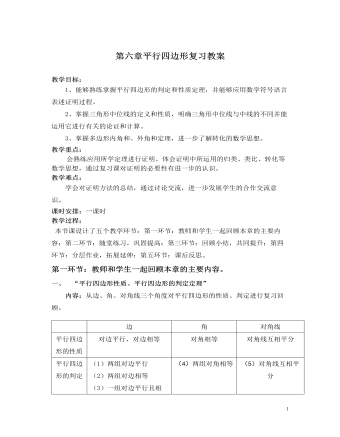
北师大初中八年级数学下册第六章复习教案
解1:设该多边形边数为n,这个外角为x°则 因为n为整数,所以 必为整数。即: 必为180°的倍数。又因为 ,所以 解2:设该多边形边数为n,这个外角为x。又 为整数, 则该多边形为九边形。第二环节:随堂练习,巩固提高1.七边形的内角和等于______度;一个n边形的内角和为1800°,则n=________。2.多边形的边数每增加一条,那么它的内角和就增加 。3.从多边形的一个顶点可以画7条对角线,则这个n边形的内角和为( )A 1620° B 1800° C 900° D 1440°4.一个多边形的各个内角都等于120°,它是( )边形。5.小华想在2012年的元旦设计一个内角和是2012°的多边形做窗花装饰教室,他的想法( )实现。(填“能”与“不能”)6. 如图4,要测量A、B两点间距离,在O点打桩,取OA的中点 C,OB的中点D,测得CD=30米,则AB=______米.
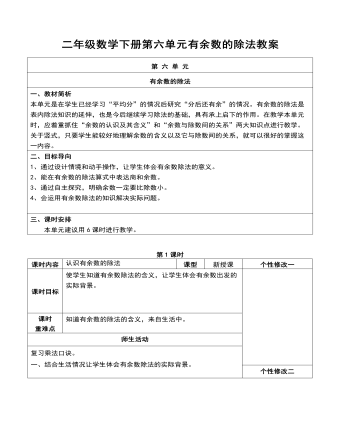
二年级数学下册第六单元有余数的除法教案
1、教学主题图。(1)让学生独立观察教材情境图。思考问题:[1]这幅画面是什么地方?[2]你发现了画面中有什么活动内容?(按顺序)(2)在小组中互相说一说自己观察到了什么内容。你想到了什么?(3)各组代表汇报。(4)教师板书学生汇报的数据。[1]这是某个校园里的活动情景图。从图中发现了教学大楼前面的两树之间都插着4面不同颜色的旗子,升旗台上也飘着一面国旗。[2]运动场上每4人一组小朋友在跳绳。[3]篮球场上每5人一组准备打篮球比赛。[4]板报下面摆的花是每3盆摆一组,旁边还有很多盆花。(5)根据上面的信息(条件),想一想能提出用除法计算的问题吗?大家在小组议一议。
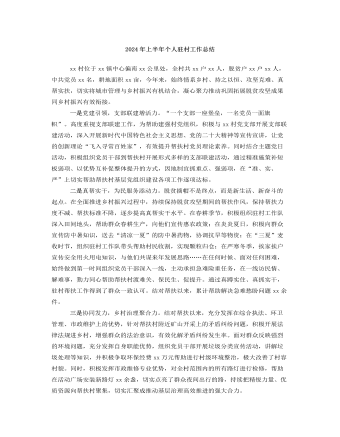
2024年上半年个人驻村工作总结(乡村振兴)
四是多措并举,产业发展尽全力。始终把产业振兴作为帮扶工作重点,帮扶之初,引导驻村工作队积极通过实地调研、培训学习等方式,组织村“两委”、产业发展能人等,集中学习产业发展相关政策、技能,外出到周边产业发展示范村等地参观学习取经,让村“两委”干部学习到先进的生产技术和管理经验,帮助他们开拓眼界、打开思路、提升技能,结合村情实际及时制定产业发展规划,最终经过多方考量、征求意见,确定以种植大棚蔬菜、精品水果和油茶等经济作物的产业发展思路。同时,还组织园林维护干部到帮扶村宣传常见病虫害及防治知识,传授种植和修剪技能,帮助提升技能技术,高效发展产业,通过签订分红合同等方式,引导企业、合作社与农户建立“风险共担、农企双赢”的利益联结机制,促进农户共享稳定收益,实现集体增收、群众致富。截至目前,共争取到项目资金、物资xx余万元,帮助发展蔬菜等xx余亩,仅2024年上半年实现销售收入xx余万元,覆盖带动全村xx户脱贫户稳定增收。
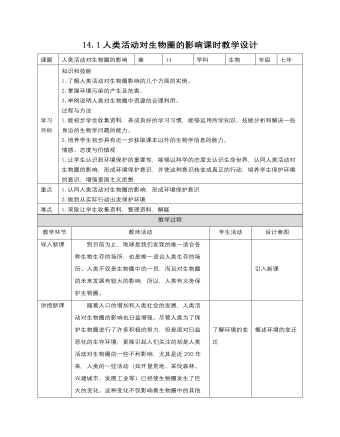
初中生物北师大版七年级下册《第14章第1节人类活动对生物圈的影响》教案
知识和技能 1.了解人类活动对生物圈影响的几个方面的实例。 2.掌握环境污染的产生及危害。 3.举例说明人类对生物圈中资源的合理利用。 过程与方法 1.能初步学会收集资料,养成良好的学习习惯,能够运用所学知识、技能分析和解决一些身边的生物学问题的能力。 2.培养学生初步具有近一步获取课本以外的生物学信息的能力。 情感、态度与价值观 1.让学生认识到环境保护的重要性,能够以科学的态度去认识生命世界,认同人类活动对生物圈的影响,形成环境保护意识,并使这种意识转变成真正的行动,培养学生保护环境的意识,增强爱国主义思想1.认同人类活动对生物圈的影响,形成环境保护意识 2.做到从实际行动出发保护环境1.采取让学生收集资料,整理资料,解疑
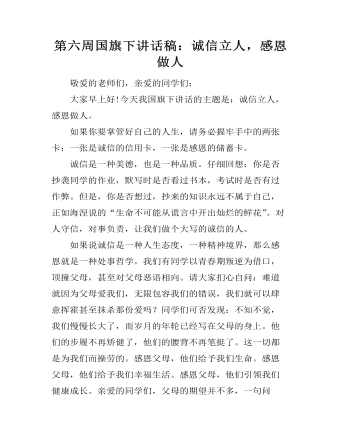
第六周国旗下讲话稿:诚信立人,感恩做人
敬爱的老师们,亲爱的同学们:大家早上好!今天我国旗下讲话的主题是:诚信立人,感恩做人。如果你要掌管好自己的人生,请务必握牢手中的两张卡:一张是诚信的信用卡,一张是感恩的储蓄卡。诚信是一种美德,也是一种品质。仔细回想:你是否抄袭同学的作业,默写时是否看过书本,考试时是否有过作弊。但是,你是否想过,抄来的知识永远不属于自己,正如海涅说的“生命不可能从谎言中开出灿烂的鲜花”。对人守信,对事负责,让我们做个大写的诚信的人。如果说诚信是一种人生态度,一种精神境界,那么感恩就是一种处事哲学。我们有同学以青春期叛逆为借口,顶撞父母,甚至对父母恶语相向。请大家扪心自问:难道就因为父母爱我们,无限包容我们的错误,我们就可以肆意挥霍甚至抹杀那份爱吗?

人教版高中地理必修2城市内部空间结构教案
过渡:在实际生活中,城市内部空间结构并非完全按照这一经济规律呈现,而是更具复杂性。这说明除了经济因素外,还有很多其他因素在起作用,请大家结合你的认识、图2.9和案例1:纽约市的少数民族区谈谈你的看法。(2)其他因素I收入——形成不同级别住宅区的常见原因。有能力支付昂贵租金和选择最佳居住环境的人,其居住地往往形成高级住宅区。II知名度——城市内某些地区在历史、文化或经济方面具有很高的声誉,这往往会吸引更多新的住宅或商场建在该处,以提高其知名度。III种族聚居区的形成——在有些城市的某一区域内,如果某个种族或宗教团体占优势,就可能形成种族聚居区。如纽约市的唐人街、哈林区、小意大利区等。IV历史因素——城市的建筑物和街道设计可以维持久远,早期的土地利用方式对日后的功能分区有着深远的影响。
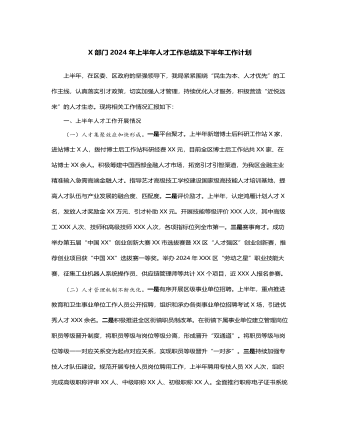
X部门2024年上半年人才工作总结及下半年工作计划
二是提速高技能人才培养。推进XX艺才高级技工学校打造我区首个技师学院,推动建立X个新职业培训示范基地、X个技能大师工作室、X个“巴渝工匠”乡村驿站,新增X家以上企业自主评价机构,提升技能人才培养层次。力争到2024年底,全区技能人才总量达到XX万人,高技能人才总量达到XX万人。三是优化人才招聘选拔机制。有序实施全区部门下属事业单位年度招聘工作,开展教育、卫生事业单位赴高校招聘应届优秀大学毕业生,规范开展基层医疗卫生机构考核招聘,进一步做好评比达标表彰工作和创建示范活动,充分发挥表彰激励作用。四是健全联系服务专家制度。坚持把搭建事业平台、发挥专家作用作为联系服务的重点,为专家创新创业提供良好条件,组织开展区内专家休假、疗养、学术交流“三位一体”活动,探索“学养结合”服务模式,打造各领域高层次人才交流互动平台。
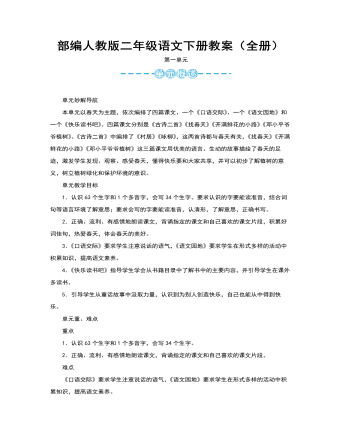
二年级语文下册教案课程全册
本文是一篇语言优美,充满儿童情趣和文学色彩的文章,仿佛呼唤着我们去寻找春天。我们到校园里找一找,也许能在操场边发现刚探出头的小草;我们到野外去找一找,也许能在天空中发现飘飘摇摇的风筝;打开课本,我们还会在课本插图中发现春天的影子;读着课文,我们会感觉自己就是那几个脱掉棉袄,冲出家门,奔向田野的孩子,我们还能体会到寻找春天的急切心情,感受到发现春天的欣喜。二年级学生具有好奇、爱探索、易受感染的心理特点,容易被新鲜的事物、活动的东西所吸引。在一年半的语文学习后,他们已经能够说一段较完整的话,并能在教师创设的情境中体验、感受,达到情感的共鸣,同时也积累了不少生活素材,这些都是学习本课的有利因素。

人教版高中语文必修3《马嵬(其二)》教案2篇
结合历史自古以来,江山美人历来都是引无数英雄豪杰竞折腰的,如果说英雄选择了美人却丢了江山,把所有罪名都归结于“女人是祸水”。但是,纣王无道,和有了妲己有必然的联系吗?有人说妲己坏透了,坏透了的妲己如果不是取得纣王的信任是坏不起来的,纣王听信了妲己的谗言,听与不听决定权在纣王,而不在妲己。强势永远在纣王一边。再来看看西施和杨贵妃:西施是作为越国贡献给吴国的供品来到吴王夫差的身边的,杨贵妃更是先是李隆基的儿媳妇被看中而得宠的。所以,西施和杨贵妃这两个可怜的女人根本没有自己的独立选择,没有独立的爱情,如果没有西施,就会有南施,或北施;如果没有杨贵妃,就会有李贵妃,王贵妃,总之什么施,什么妃是不能少的,因为那是吴王和李隆基的需要。

人教版高中语文必修5《归去来兮辞(并序)》教案
【教学目标】1.理解作者反抗黑暗,辞官归田,不与当时黑暗的上层社会同流合污而热爱田园生活的积极精神,学习其高洁的理想志趣和坚定的人生追求。2.掌握“胡、奚、曷、焉、何”五个疑问代词,归纳“行、引、乘、策”等四个词的一词多义,了解“以、而、之、兮、来”等文言虚词的用法。3.背诵全文。【教学重点】1.了解作者辞官归田的原因,深刻体味诗人鄙弃官场,热爱田园的无限欣喜之情。2.背诵全文。【教学难点】1.理解记述中渗透出的或喜或哀,或决绝或犹疑的复杂感情。2.归纳实词、虚词的用法,掌握省略句、倒装句两种句式。【教具准备】投影仪投影胶片【课时安排】2课时【教学过程】第一课时[教学要点]了解陶渊明及其作品。读课文,利用注释、工具书,初步把握文章,朗读课文,找出押韵的字,由押韵归纳各层大意,帮助学生理清背诵思路,背诵全文。[教学步骤]一、导语《桃花源记》是我们在初中接触过的陶渊明的作品。师生一同背诵。《桃花源记》中悠闲自得的田园生活正是作者精神追求的形象反映。今天我们学习的《归去来兮辞》正是作者决别官场,同上层社会分道扬镳的宣言书。
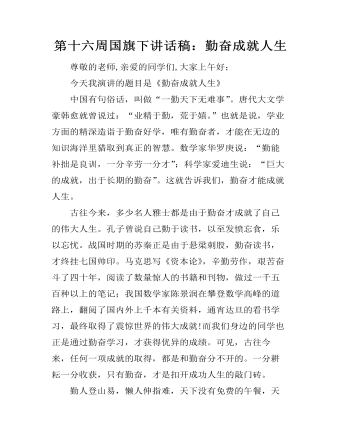
第十六周国旗下讲话稿:勤奋成就人生
尊敬的老师,亲爱的同学们,大家上午好;今天我演讲的题目是《勤奋成就人生》中国有句俗话,叫做“一勤天下无难事”。唐代大文学豪韩愈就曾说过:“业精于勤,荒于嬉。”也就是说,学业方面的精深造诣于勤奋好学,唯有勤奋者,才能在无边的知识海洋里猎取到真正的智慧。数学家华罗庚说:“勤能补拙是良训,一分辛劳一分才”;科学家爱迪生说:“巨大的成就,出于长期的勤奋”。这就告诉我们,勤奋才能成就人生。古往今来,多少名人雅士都是由于勤奋才成就了自己的伟大人生。孔子曾说自己勤于读书,以至发愤忘食,乐以忘忧。战国时期的苏秦正是由于悬梁刺股,勤奋读书,才终挂七国帅印。马克思写《资本论》,辛勤劳作,艰苦奋斗了四十年,阅读了数量惊人的书籍和刊物,做过一千五百种以上的笔记;我国数学家陈景润在攀登数学高峰的道路上,翻阅了国内外上千本有关资料,通宵达旦的看书学习,最终取得了震惊世界的伟大成就!而我们身边的同学也正是通过勤奋学习,才获得优异的成绩。可见,古往今来,任何一项成就的取得,都是和勤奋分不开的。一分耕耘一分收获,只有勤奋,才是扣开成功人生的敲门砖。

人教版新课标高中物理必修1用牛顿运动定律解决问题(二)教案2篇
观察实验视频实验验证师:其实大家完全可以利用身边的器材来验证。实验1、用弹簧秤挂上钩码,然后迅速上提和迅速下放。现象:在钩码被迅速上提的一瞬间,弹簧秤读数突然变大;在钩码被迅速下放的一瞬间,弹簧秤读数突然变小。师:迅速上提时弹簧秤示数变大是超重还是失重?迅速下放时弹簧秤示数变小是超重还是失重?生:迅速上提超重,迅速下放失重。体会为何用弹簧秤测物体重力时要保证在竖直方向且保持静止或匀速实验2、学生站在医用体重计上,观察下蹲和站起时秤的示数如何变化?在实验前先让同学们理论思考示数会如何变化再去验证,最后再思考。(1)在上升过程中可分为两个阶段:加速上升、减速上升;下蹲过程中也可分为两个阶段:加速下降、减速下降。(2)当学生加速上升和减速下降时会出现超重现象;当学生加速下降和减速上升时会出现失重现象;(3)出现超重现象时加速度方向向上,出现失重现象时加速度方向向下。完全失重

人教版高中地理必修2城市内部空间结构精品教案
过渡:在实际生活中,城市内部空间结构并非完全按照这一经济规律呈现,而是更具复杂性。这说明除了经济因素外,还有很多其他因素在起作用,请大家结合你的认识、图2.9和案例1:纽约市的少数民族区谈谈你的看法。(2)其他因素I.收入 —— 形成不同级别住宅区的常见原因。有能力支付昂贵租金和选择最佳居住环境的人,其居住地往往形成高级住宅区。II.知名度 ——城市内某些地区在历史、文化或经济方面具有很高的声誉,这往往会吸引更多新的住宅或商场建在该处,以提高其知名度。III.种族聚居区的形成 ——在有些城市的某一区域内,如果某个种族或宗教团体占优势,就可能形成种族聚居区。如纽约市的唐人街、哈林区、小意大利区等。IV历史因素——城市的建筑物和街道设计可以维持久远,早期的土地利用方式对日后的功能分区有着深远的影响。3、城市内部空间结构的形成和变化
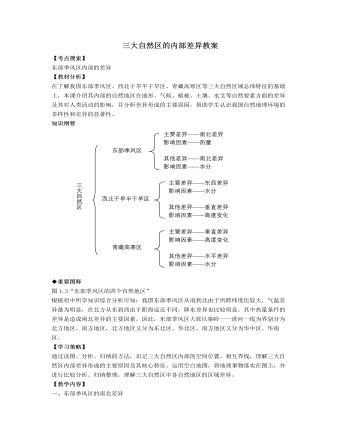
人教版高中地理选修2三大自然区的内部差异教案
【知能训练】一、选择题(第1-5题为单项选择题,第6-7题为双项选择题)东北温带湿润、半湿润地区内的三江平原有“北大荒”之称,如今“北大荒”已被人们称为“北大仓”。据此完成1-2题:1、下列关于三江平原的叙述,正确的是()A.地处中温带湿润地区B.因粮食单位面积产量高而成为全国性的商品粮基地之一C.土壤因富含矿物质而形成肥沃的黑土D.夏季高温且雨热同期,利于冬小麦、玉米种植2、目前,三江平原还有大片沼泽荒地,但2000年国务院下令停止围垦,其主要原因是()A.我国已加入WTO,可以从国际市场大量廉价进口粮食B.保护“湿地”有利于改善生态环境C.开展多种经营,发展菱藕等水生植物生产D.煤、石油等矿产资源丰富,今后转向矿产资源开发利用3、我国西部地区的地理差异有()A.甘新多沙漠戈壁,青藏多大河湖泊B.陕甘宁地势低平,云贵川地形崎岖



